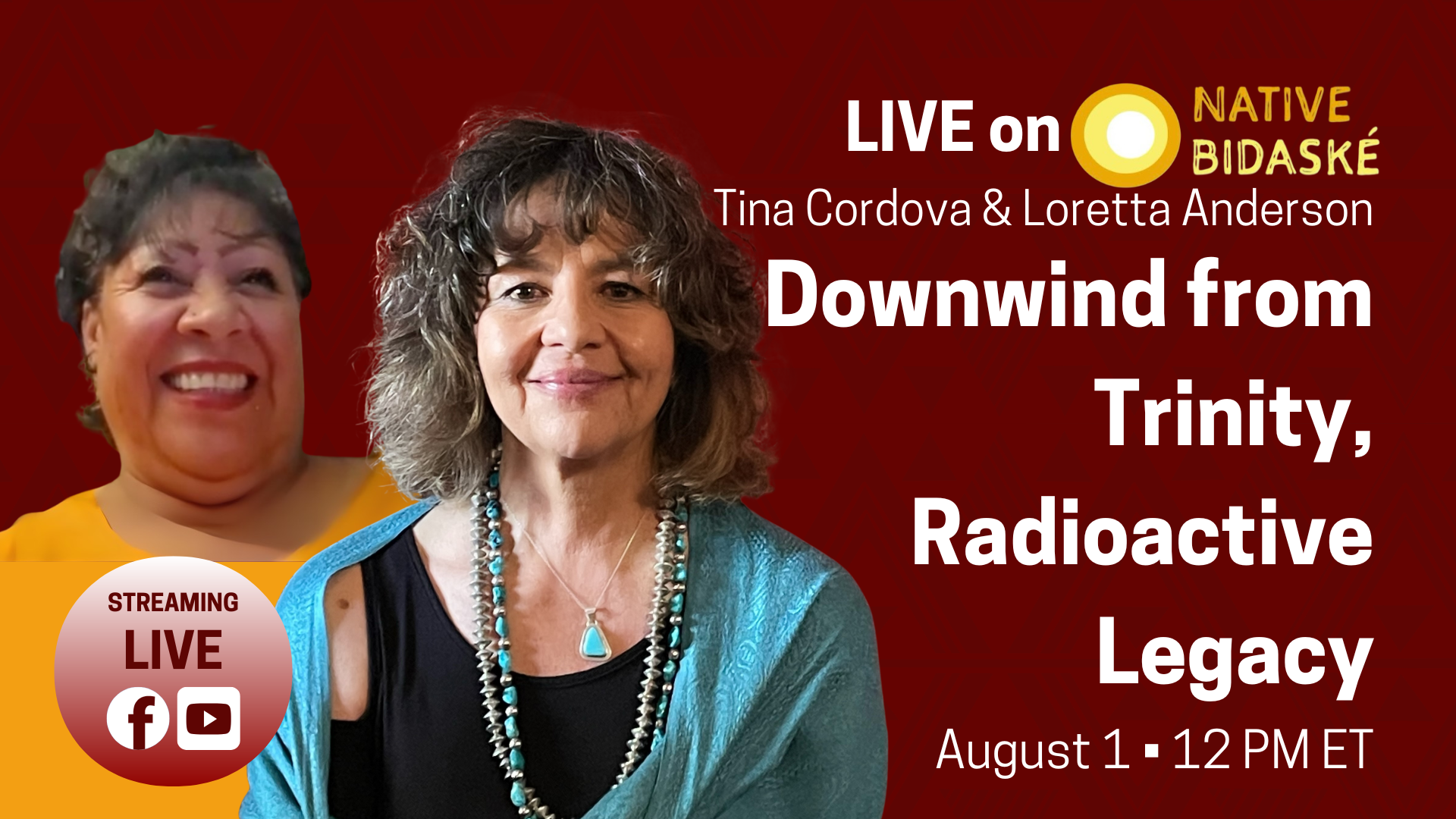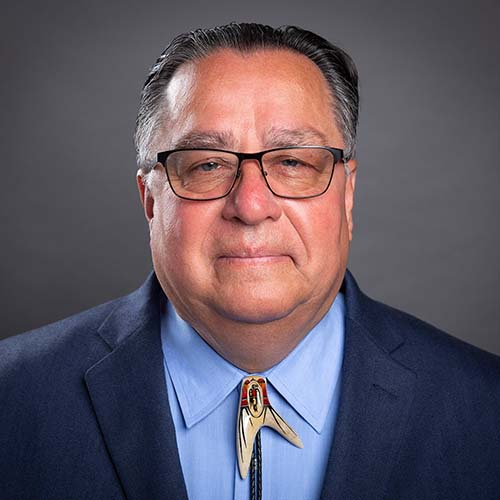
- Details
- By Native StoryLab
In 1945, the U.S. government detonated the first-ever nuclear bomb in the New Mexico desert. But while history books focus on the birth of the atomic age, they largely ignore the slow, invisible war it unleashed on the people living nearby, many of them Indigenous.
On the latest episode of Native Bidaské, host Levi Rickert sat down with Tina Cordova and Loretta Anderson, two women who’ve spent decades fighting for justice for uranium workers, downwind families, and Native communities poisoned by America’s nuclear legacy. Their stories reveal an 80-year pattern of exposure, illness, loss, and now, the first glimmers of overdue compensation.
Tina Cordova, co-founder of the Tularosa Basin Downwinders Consortium, has spent 20 years documenting the impact of radioactive fallout on New Mexico families. She’s the fourth generation in her family to be diagnosed with cancer since the Trinity Test. “Almost 100% of my immediate family has had cancer,” she told Bidaské viewers. “And my family’s not unique.”
Her coalition has uncovered data showing a dramatic rise in infant deaths after the Trinity detonation, jumping from 30 to over 100 deaths per 1,000 births that summer alone. The U.S. government never warned residents, never cleaned up the contamination, and never returned to assess the damage. “They didn’t want to see us, so they didn’t see us,” Cordova said.
Loretta Anderson, of the Pueblo of Laguna, has seen the same story unfold around uranium mines. She co-founded the Southwest Uranium Miners Coalition to support miners, many Native, who were exposed with little protection and even less information. “Our people are sick. Our children are being diagnosed with cancer. We mourn every week,” she said. “And our lands, air, and water are still contaminated.”
Both women spoke of the generational grief, loss, and injustice their communities continue to face. “Money can’t buy life,” Anderson said. “I’d give anything to have my father back. He died of cancer from working in the mines. My mother worked in the office at the mine and developed pulmonary fibrosis. She doesn’t even qualify for compensation.”
For decades, the federal government has offered limited assistance under the Radiation Exposure Compensation Act (RECA), but left out post-1971 uranium workers and most downwind communities in New Mexico. That changed last month when President Trump signed a provision in the federal budget extending RECA by two years and expanding eligibility. The new $8 billion package includes:
- Coverage for uranium miners and workers expanded
- $100,000 payments for qualifying downwinders
- Downwinders who lived in New Mexico for one year from 1944 through Nov. 1962 will be eligible, and family members can apply on behalf of a deceased loved one
More information on the expansion to RECA is summarized here.
While it's a step forward, Cordova calls it “a pittance” compared to the nearly $10 trillion spent on nuclear development. “We wanted health care coverage for all downwinders,” she said. “They stripped that out, saying it would cost too much.”
Anderson added, “Now that money’s coming, the scammers are too. Our coalition is shifting focus; we’re training people to help communities file claims properly. No one should have to pay an attorney to get what they deserve.”
Both women emphasized the urgency of educating communities, especially with uranium mining and nuclear testing on the rise again. “They counted on us to be uneducated and unable to speak up in the 1940s. We’re not those people anymore,” Cordova said. “We’ve borne our share. We won’t be collateral damage again.”
To learn more or get help with the claims process, visit: www.trinitydownwinders.com
🎥 Watch the full Native Bidaské episode here:
Help us tell the stories that could save Native languages and food traditions
At a critical moment for Indian Country, Native News Online is embarking on our most ambitious reporting project yet: "Cultivating Culture," a three-year investigation into two forces shaping Native community survival—food sovereignty and language revitalization.
The devastating impact of COVID-19 accelerated the loss of Native elders and with them, irreplaceable cultural knowledge. Yet across tribal communities, innovative leaders are fighting back, reclaiming traditional food systems and breathing new life into Native languages. These aren't just cultural preservation efforts—they're powerful pathways to community health, healing, and resilience.
Our dedicated reporting team will spend three years documenting these stories through on-the-ground reporting in 18 tribal communities, producing over 200 in-depth stories, 18 podcast episodes, and multimedia content that amplifies Indigenous voices. We'll show policymakers, funders, and allies how cultural restoration directly impacts physical and mental wellness while celebrating successful models of sovereignty and self-determination.
This isn't corporate media parachuting into Indian Country for a quick story. This is sustained, relationship-based journalism by Native reporters who understand these communities. It's "Warrior Journalism"—fearless reporting that serves the 5.5 million readers who depend on us for news that mainstream media often ignores.
We need your help right now. While we've secured partial funding, we're still $450,000 short of our three-year budget. Our immediate goal is $25,000 this month to keep this critical work moving forward—funding reporter salaries, travel to remote communities, photography, and the deep reporting these stories deserve.
Every dollar directly supports Indigenous journalists telling Indigenous stories. Whether it's $5 or $50, your contribution ensures these vital narratives of resilience, innovation, and hope don't disappear into silence.
 The stakes couldn't be higher. Native languages are being lost at an alarming rate. Food insecurity plagues many tribal communities. But solutions are emerging, and these stories need to be told.
The stakes couldn't be higher. Native languages are being lost at an alarming rate. Food insecurity plagues many tribal communities. But solutions are emerging, and these stories need to be told.
Support independent Native journalism. Fund the stories that matter.
Levi Rickert (Potawatomi), Editor & Publisher
